It’s difficult to be visionary

“AI and digital transformation will have a more profound impact on humanity than electricity or fire”
In early 2018, Infosys surveyed more than 1,000 senior management level executives working in large organisations around the world with more than 5,000 employees and over US $1 billion in annual revenue. We found that incumbent organisations (as opposed to digital natives) fall into three clusters determined by their progress along the digital transformation journey:
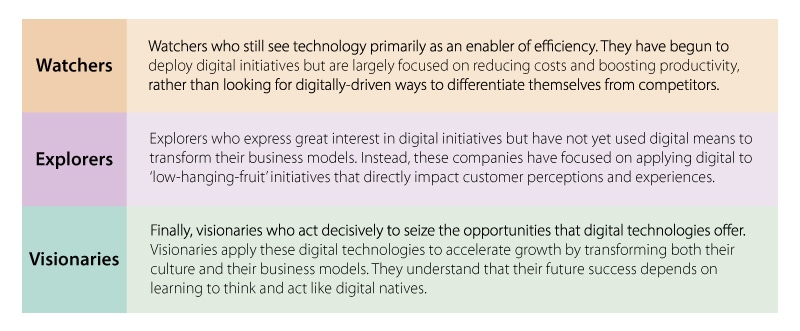
With many organisations rapidly intensifying their digital transformation efforts, Infosys conducted a new survey in November 2018 to gauge the pace of that change. This new survey shows that the percentage of visionaries among survey respondents has remained essentially unchanged, but many companies have migrated upward from the watcher to the explorer level (see Exhibit 1). These findings match what executives have told us – companies can advance from the watcher to the explorer level without herculean effort, but reaching the visionary level is significantly more difficult, and often requires amplifying core parts of the business, whilst remaining open to the possibility of letting a partner take the helm.
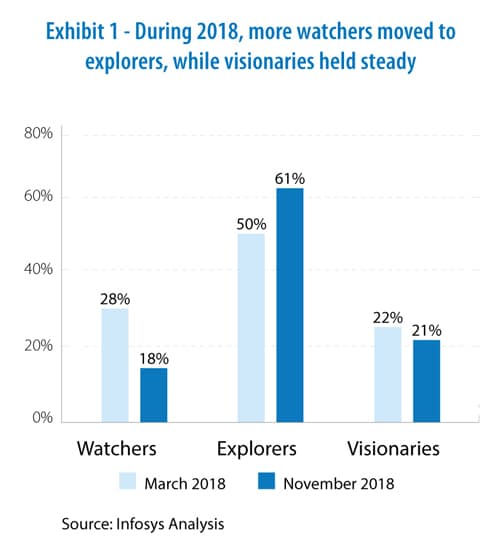
Getting ahead in a customer-first market
Almost every incumbent is being pushed by disruptors or peers to transform digitally. Stephen Lynch, CIO for Consumer Banking at a leading US financial institution, believes that the pace and magnitude of the current technology-driven changes are unprecedented.

“Organisations have never had to transform in this manner before,” he says. “It’s very exciting — almost on par with the launch of the Internet. It’s changing the economy so fast that we’re going to need all the global thought power we can get.”
Many companies will only survive if they become digital transformation visionaries. “Digital natives are growing fast and getting to billion-dollar valuations in record time,” points out Rohit Setia, Executive Director IT at Estée Lauder. “We’re an explorer, but to survive, we need to become a visionary organisation. It’s a struggle to get there.”
In this new connected world, customers are leveraging and adopting new digital technologies in new ways – with needs and habits changing every month.
These customers are better informed than ever and expect high-quality, frictionless customer experiences and enhanced services at lower costs and in a timely manner. If businesses get digital right, these customers are also more satisfied and loyal in the long run. McKinsey research among telecommunications shows that customers who use digital channels are one-third more satisfied than those who rely on traditional channels. Some incumbents unable to keep up with the pace of this technological change have already succumbed to competitive pressures. Many more will likely fall by the wayside. To avoid being blindsided by competitors and stay relevant, companies must find ways to transform their products, processes and business models using digitally-enabled approaches and technologies, always with the customer in mind.
Digital initiatives at scale
The study that Infosys conducted in November 2018 took a closer look at the transformation journey of organisations.
Infosys identified 22 digital initiatives and then asked respondents where their companies stood on implementing each initiative:
- Not started (or in planning)
- Completed multiple proofs of concept
- Completed pilot projects
- Operating at scale
We built a Digital Maturity Index where each company was assigned an index score from 0 to 100 according to its progress in pursuing and implementing the 22 initiatives. As can be seen from Exhibit 2, there are many more explorers than watchers and visionaries.
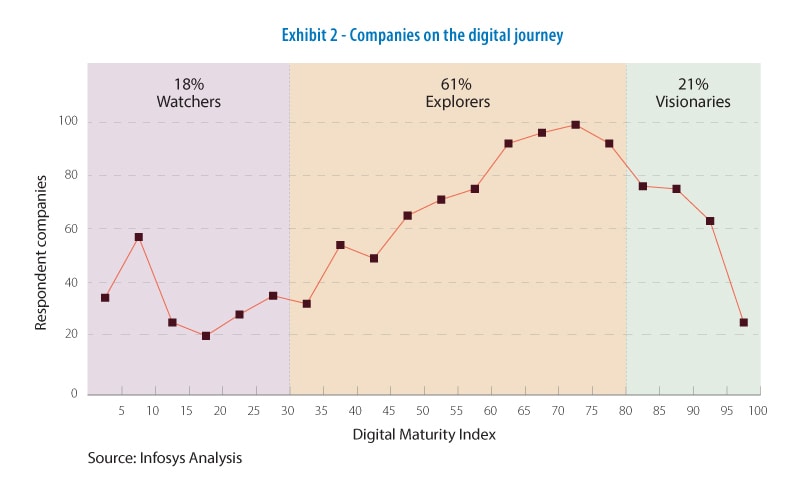
Comparing clusters on their digital transformation journeys
As companies advance through the digital transformation journey from watchers to explorers to visionaries, they operate more and more key digital initiatives at scale. The types of projects change throughout the journey and can be grouped into four categories:
- Foundation initiatives must be implemented to modernise legacy systems
- Mainstay initiatives represent the core elements of digital transformation, including automation and artificial intelligence (AI)
- Customer initiatives primarily impact the customer experience. They include digital marketing, omni channel marketing, and content personalisation
- Forefront initiatives harness cutting-edge technologies, such as augmented reality (AR), drones, and blockchain

As can be seen from Exhibit 3, visionaries are significantly ahead across all four categories.
If a company lags on these digital initiatives, in the short-term it is a good idea to stay focussed on mainstay and customer initiatives that keep the customer front and centre (more on customer-centric strategy later). By investing in business intelligence, you will quickly make progress in big data and analytics, before shifting attention to core customer capabilities such as digital marketing and digital product engineering.
To become a visionary, companies should operate at scale for at least 12 of these digital initiatives, with pilots active on seven additional ones. Also, pursue forefront initiatives such as virtual reality and blockchain where needed.
To do this, it is important to develop a ‘lean forward’ mindset, realising that today’s advanced technologies become tomorrow’s everyday operating system.
Act decisively to seize opportunities and apply digital technologies to transform both culture and business models. You will find that this comprehensive approach will ensure digital leadership in the market, catalysing synergy across initiatives (success in one area like big data may provide core capabilities for another initiative like IoT).
In the next section we will explore how a customer centric approach to transformation can expedite the shift from an explorer to a visionary organisation. With a platform such as Salesforce, you can tap into a trove of digital capabilities to move up the digital transformation ladder, while beginning to think, act, and move like a digital native.
From explorer to visionary: customer-centric transformation
Much talk has been bandied about ‘putting the customer first’. In days gone by, this talk didn’t keep CEOs up at night. With customer behaviour changing day to day, the term is more prescient than it used to be; it is, in fact, one of the primary reasons that organisations are evolving their digital capabilities.
In this context, according to a report by Forrester Consulting, digital leaders (i.e. visionaries) focus much of their efforts on keeping step with changing customer behaviour (48 percent compared with 35 percent of digital laggards).
The good news is that the technology that is changing this customer behaviour (think mobile devices, social media, the cloud, IoT, and AI) is also available to businesses that need to create completely new customer journeys that have finely-grained emotive impact.
Amazon, Apple, and Uber are at the forefront of deep customer-centricity, with intuitive, wrap around customer experiences that leverage many of the mainstay and customer digital initiatives we have spoken about. As data is fed into their systems, these digital pure players learn more about a customer’s needs and can respond in real-time, with recommendations and offers that are just one click away. In another example, manufacturing-system producers can leverage new technologies to deliver just-in-time analytics and predictive maintenance to their field workers and customers.
But these tailored customer journeys are only possible with a 360-view of the customer or client. To do this, organisations must instil a mandate, and utilise technology, that connects marketing, sales, service and commerce systems, along with back-end IT processes.
Along with enabling greater customer personalisation, this 360-view also provides customers with a connected experience (or customer journey) across the entire organisation. And this is becoming ever more important.
Salesforce’s 2018 “Trends in Integrated Customer Experiences” report found that 70% of customers will stay with firms that offer connected experiences (such as contextualised engagement based on earlier interactions).
This 360-view also helps companies establish a true omni-channel perspective within their organisations, and drives further digital maturity.
Explorer organisations must take advantage of a simple, intuitive platform to transform in this way. This platform must not only connect all data and devices but, using deep analytical insights, augment the intelligence collected (the agility of the cloud to integrate data from third-parties is central here). Organisations must also start with the customer journeys that matter most.
The effort can pay off handsomely; according to McKinsey, firms can observe up to 15 percent revenue increases and simultaneous reductions in cost-to-serve of more than 20 percent.
Salesforce as transformation platform
Starting with the customer journeys that matter most, digital explorers can quickly scale up their digital initiatives in the mainstay and customer segments to bring about a complete customer centric transformation.
While Salesforce is best known for serving sales organisations and consumerising the employee service experience, it has also taken steps to bring Digital Transformation 2.0 to clients’ customer journeys. Capabilities like Force.com (a digital development platform), Salesforce CRM (one point of call for managing the customer), Einstein (AI engine), predictive analytics, Mulesoft (for APIs) and Lightning Process Builder (automating digital marketing sales service processes) allow a comprehensive approach to scale up mainstay and customer initiatives with quick time to value.
The platform also combines database models, integration services (integration with other web platforms, ERP, and legacy systems is possible), rapid visual development and reporting/management services.
Put simply, all 22 initiatives (across foundation, mainstay, customer and forefront technologies) highlighted in this report can be brought to scale using Salesforce. Much like scaffolding around a new building, the Salesforce platform can accelerate and de-risk digital transformation, keeping the focus on business outcomes rather than technology.
Airbus is a good example of how other organisations are scaling up their digital initiatives using this platform. As part of a customer-centric digital transformation strategy, the aircraft giant is deploying Salesforce Service Cloud Einstein to deliver predictive and personalised customer experiences.
This will allow Airbus to understand its customers’ desires more precisely and make smarter decisions that strengthen customer relationships and outcomes.
Another example utilising mainstay and customer initiatives in digital transformation comes from the wealth management industry. United Capital in California used Salesforce to transform its wealth management process, creating custom applications built on the Salesforce App Cloud, giving customers complete control over their financial life through a proven system. They built an interactive reporting app that acts as a central point of access to other United Capital tools, helping clients define life priorities, determine portfolio preferences, and make spending decisions using real-time data.
For organisations unsure of how to go about transforming to a visionary customer-centric company, select upwards of 10 mainstay and customer initiatives that are available on the Salesforce platform, and design a transformation strategy that will accelerate the journey across products, processes, and business models. We will discuss this in the chapters that follow.
Barriers to transformation
Our survey revealed that an inability to experiment quickly is the greatest barrier to digital transformation that companies faced in 2018. More than half of respondents (53%) worried that their companies lacked the capacity for rapid experimentation, essential for testing different technologies and figuring out the most promising one.
That said, most companies believe that they can quickly develop this capability. Only 22% of respondents felt that lack of rapid experimentation skills would still frustrate their digital transformation in 2019.
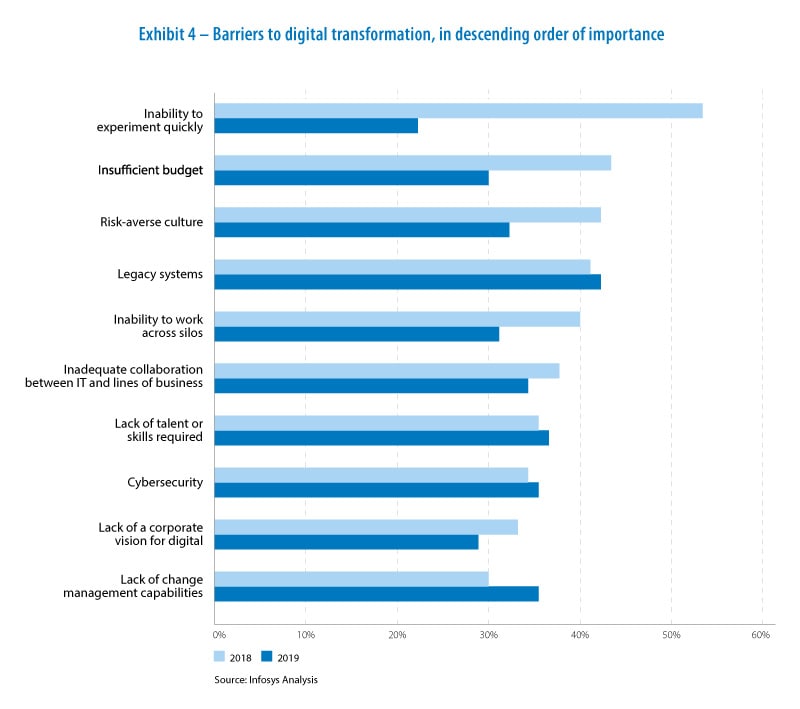
For those wishing to make full use of the Salesforce Suite (Infosys can help here with their DevOps model of engagement) and become adept at rapid experimentation, the need to implement major cultural changes in an organisation is critical. But according to Alok Uniyal, Head of Agile and DevOps at Infosys, significant cultural shifts rarely happen quickly.
And while survey respondents feel that most barriers to digital transformation will diminish over time, most have persistent concerns over legacy systems.
Legacy systems ranked as the fourth most commonly cited barrier in 2018, but participants expect it to become the greatest bottleneck to transformation in 2019.
Yvonne Burkhouse, CIO at HAAH Automotive Holdings, USA, cites her company’s cloud-infrastructure as one of their major competitive advantages. “We have no legacy systems; all are cloud-based technologies designed not only to meet all our needs now but also be flexible, scalable, and adaptable in the future.”
That said, once organisations progress further in their transformation journey, other barriers emerge to impede progress. In our survey, it was actually the visionary organisations that cited the most barriers, though they were also the ones that were the most optimistic (compared to watchers and explorers) about surmounting these obstacles. As companies become more confident with their digital transformation, they find it easier to bring more digital ideas to scale.
Five accelerator capabilities
Five capabilities help enterprises accelerate digital transformation success:
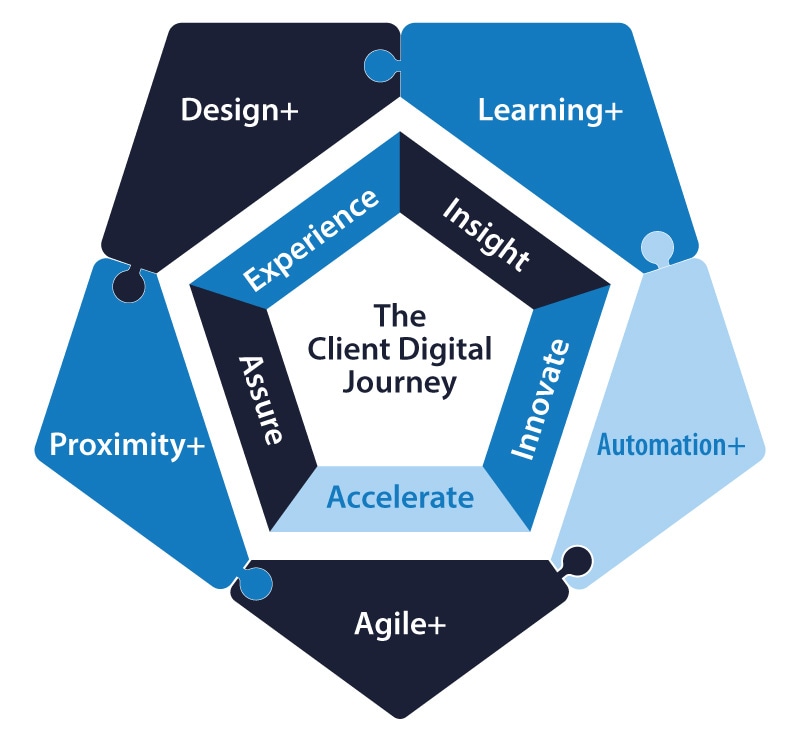
- Agile/DevOps success depends on doing agile and being agile, with a change in culture and mindset to ensure early IT and business collaboration
- Visionaries approach automation and AI as a way to amplify human capabilities rather than just reduce headcount and costs
- Visionaries measure design performance and results with the same rigour that they apply to track revenues and costs
- Visionaries stand out by investing in the digital tools and infrastructure necessary to support robust, always-on, continuous learning and reskilling programmes for employees
- Effective employee location strategies that balance cost with proximity to partners and customers are yielding results for visionaries
The five digital capability accelerators above are each powerful in their own right, and when used with an all encompassing digital platform like Salesforce, visionary status is easier to achieve. It is interesting to note that visionaries score consistently higher across all accelerators (Exhibit 5).
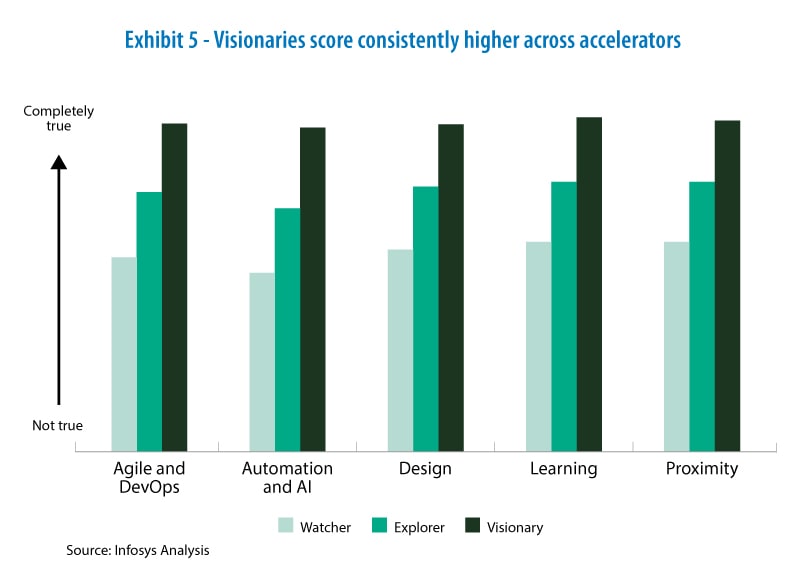
When Infosys reviewed client and industry digital transformation programmes, we found multiple successes in the past two years where one of the accelerators was dominant. However, in discussions with executives about the next twelve months and beyond, the consistent message was that multiple accelerators will increasingly be needed for future success.
Agile and DevOps programmes will be required for the uncertainty that accompanies the frenetic ongoing pace of change. The amplification and intelligence from automation and AI will be required to make sense of an increasingly complex world.
Design will become a non-negotiable expectation that goes beyond functionality to experience, and will permeate more and more business functions.
The rate of change faced by enterprises, and the necessity for widespread adoption, virtually guarantees that learning will be a core part of any lasting transformation. Finally, the location or proximity of work will be a major factor in capability and programme planning, both for strategic intent and cost management.
What sets visionaries apart?
“If you have the right systems and process, a small number of talented individuals can have a big impact on a company’s digital transformation journey.”
– Corey Glickman, InfosysFor companies at the explorer stage, what does it take to reach the visionary level? What really sets visionaries apart from watchers and explorers?
According to our research, visionaries stand out in the way that they have fully embraced the mindset and practices of both being agile and doing agile.
Also, to become more like visionaries, companies should share their digital transformation strategy with employees, customers and partners alike.
For companies considering Salesforce as part of their transformation strategy, what might that look like? What initiatives are to be tackled first and how will other more forward-thinking digital assets be used later on down the line?
A recommended initial step is to develop a comprehensive strategy for using AI and automation (think Salesforce Einstein) to bolster human capabilities, rather than just focussing on cutting costs.
To further boost the digital transformation path:
- Amplify existing capabilities by focussing on high value projects with the greatest potential impact (or the customer journey that matters most), and
- Partner with other organisations like Salesforce and Infosys to gain access to complementary skills and resources
Amplify
To get to visionary status, focus efforts on the largest problems first (such as the different touch points on the customer journey). Solutions to these problems will likely have the greatest potential impact.
Different parts of an organisation can be at different points on their transformation journey, and companies need to factor this into their planning.
Finally, have a long-term perspective to do what is needed, while forging ahead on initiatives that factor in short-term needs (e.g. automation, compliance, and agile processes).
Partner
From our research, we have found that as companies become more mature on their digital transformation journey, they are more likely to let partners like Salesforce run and deliver initiatives on their behalf.
As can be seen from Exhibit 6, partnering increases chances for success and benefits from much quicker implementation.
By realising quick-wins on the projects that matter short-term companies put themselves in better position to capitalise on future partnering opportunities. Also, by building up digital capabilities, they are in a better position to build and run partnerships effectively (due to process and governance maturity).
Visionaries also realise the value in letting partners both lead and deliver on forefront initiatives like RPA, blockchain, 3D printing, and AI, while technologies such as cybersecurity and IoT can follow a more company-led partnering model.

The digital future is arriving at a rapid pace, and the consequences for inaction are more severe than ever. With proper planning, cooperation, and commitment, business leaders and IT professionals can work together to position their companies for success, no matter which direction the winds may blow.
For enterprises focussed on achieving visionary status, Salesforce is a platform that can aid that journey. Properly implemented, it can drive quick-wins, while setting the stage to reap the rewards of customer and client loyalty further down the line.
Sources
- https://www.salesforce.com/products/platform/best-practices/digital-transformation-framework/
- https://stefanini.com/en/trends/articles/how-salesforce-can-help-power-digital-transformation
- https://ortooapps.com/salesforce-crm-boosts-digital-transformation/
- https://martechseries.com/sales-marketing/customer-experience-management/salesforce-to-drive-airbus-digital-transformation-with-a-focus-on-customer-experience/
- https://www.wns.com/insights/articles/articledetail/397/achieving-customer-centricity-through-digital-transformation
- https://www.forbes.com/sites/forbestechcouncil/2018/01/24/a-customer-centric-approach-must-drive-digital-transformation/#12efbd2962c4
- https://advisory.kpmg.us/blog/2018/mc-four-fundamentals-of-customer-centric-digital-transformation.html
- https://www.mckinsey.com/business-functions/operations/our-insights/mastering-the-digital-advantage-in-transforming-customer-experience
- https://www.salesforce.com/blog/2019/01/how-to-create-a-customer-centric-experience.html





